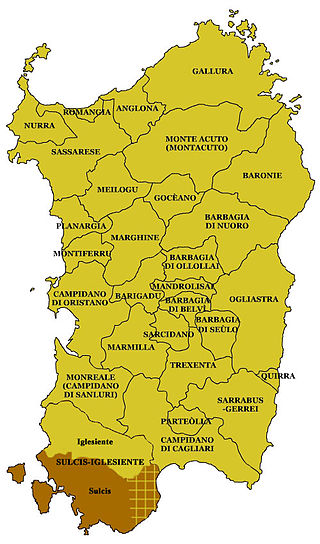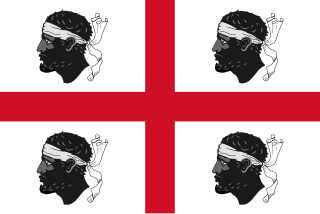History
The castle was probably built by the Della Gherardesca which became masters of the south-west of Sardinia after the partition of Giudicato of Cagliari that took place in 1258. However, according to another hypothesis, its construction would be dated to the 12th century, during the reign of William I of Cagliari.
It's located on the border between the territory of Ugolino della Gherardesca (curatoria of Cixerri) and the heirs of Gherardo della Gherardesca (curatoria of Sulcis, Nora and Decimo). It was occupied for a short period, between 1290 and 1295 approximately, from Guelfo della Gherardesca, son of the late Count Ugolino, who was trying to conquer the land held by the other Della Gherardesca: Ranieri and Boniface.
Following the wars between the giudicato of Arborea and the Kingdom of Sardinia, the castle assumed again a military function; the documents show that it was conquered and occupied temporarily by Brancaleone Doria, husband of Eleanor of Arborea.
The castle, in later centuries, passed into the hands of various Aragonese feudal lords.

The Judicates, in English also referred to as Sardinian Kingdoms, Sardinian Judgedoms or Judicatures, were independent states that took power in Sardinia in the Middle Ages, between the eleventh and fifteenth centuries. They were sovereign states with summa potestas, each with a ruler called judge, with the powers of a king.

Iglesias is a comune and city in the province of South Sardinia, Italy. It was co-capital of the province of Carbonia-Iglesias with Carbonia, and the province's second-largest community.

The Judicate of Arborea or the Kingdom of Arborea was one of the four independent judicates into which the island of Sardinia was divided in the Middle Ages. It occupied the central-west portion of the island, wedged between Logudoro to the north and east, Cagliari to the south and east, and the Mediterranean Sea to the west. To the northeast of Logudoro was Gallura, with which Arborea had far less interaction. Arborea outlasted her neighbours, surviving well into the 15th century. At its greatest territorial extent it occupied the entire island except the cities of Alghero and Cagliari. The earliest known judicial seat was Tharros, though Oristano served as capital for most of its existence.

Decimomannu is a comune in the Metropolitan City of Cagliari, Sardinia, Italy. It is located about 17 km (11 mi) northwest of central Cagliari and had a population of about 8,115 As of 2014.

Domusnovas, Domusnoas or Domus Noas in Sardinian language, is a comune (municipality) in the Province of South Sardinia in the Italian region Sardinia, located about 40 kilometres (25 mi) northwest of Cagliari and about 20 kilometres (12 mi) northeast of Carbonia, in the Sulcis-Iglesiente region, in the valley of the Cixerri river.

Sant'Andrea Frius is a comune (municipality) in the Province of South Sardinia in the Italian region Sardinia, located about 30 kilometres (19 mi) north of Cagliari.

The Judicate of Cagliari was one of the four kingdoms or judicates into which Sardinia was divided during the Middle Ages.
Torchitorio V, born John and known as Chiano or Chianni, was the Giudice (Judge) of Cagliari from 1250 to his death. His reign was brief but transformative in the history of Sardinia.
William III, of the House of Massa, was the last Judge of Cagliari, ruling under the name Salusio VI from 1256 to his deposition in 1258. He is also known as Guglielmo Cepolla or Cipolla.

The House of Gherardesca was an ancient Italian noble family of the Republic of Pisa, of Longobard origin. The family likely dates back as early as the 11th century.

Marianus II was the Judge of Arborea from 1241 to his death. With skilled military action, he came to control more than half of the island of Sardinia. By his control of the vast central plains and the rich deposits of precious metals, he increased the riches of his Judicate and staved off the general economic decline affecting the rest of Europe at the time.
Anselm of Capraia was a Pisan count. His political activity extended from the Republic of Pisa to Sardinia.

Sulcis is a subregion of Sardinia, Italy, in the Province of South Sardinia.

The Kingdom of Sardinia, also referred to as the Kingdom ofSardinia-Piedmont, Sardegna and Corsica or Piedmont–Sardinia as a composite state during the Savoyard period, was a country in Southern Europe from the late 13th until the mid-19th century; officially 1297 to 1768 for the Corsican part of this kingdom.
This article presents a history of Cagliari, an Italian municipality and the capital city of the island of Sardinia. The city has been continuously inhabited since at least the neo-lithic period. Due to its strategic location in the Mediterranean and natural harbor, the city was prized and highly sought after by a number of Mediterranean empires and cultures.

The Aragonese conquest of Sardinia took place between 1323 and 1326. The island of Sardinia was at the time subject to the influence of the Republic of Pisa, the Pisan della Gherardesca family, Genoa and of the Genoese families of Doria and the Malaspina; the only native political entity survived was the Judicate of Arborea, allied with the Crown of Aragon. The financial difficulties due to the wars in Sicily, the conflict with the Crown of Castile in the land of Murcia and Alicante (1296–1304) and the failed attempt to conquer Almeria (1309) explain the delay of James II of Aragon in bringing the conquest of Sardinia, enfeoffed to him by Pope Boniface VIII in 1297.

The Castle of Acquafredda is a medieval castle in Siliqua, province of South Sardinia, Italy.

The Castle of San Michele is a medieval castle in Cagliari, the capital of Sardinia, Italy.

The Marquisate of Oristano was a marquisate of Sardinia that lasted from 1410 until 1478

The Sardinian–Aragonese war was a late medieval conflict lasting from 1353 to 1420. The fight was over supremacy of the land and took place between the Judicate of Arborea -- allied with the Sardinian branch of the Doria family and Genoa -- and the Kingdom of Sardinia, the latter of which had been part of the Crown of Aragon since 1324.

















